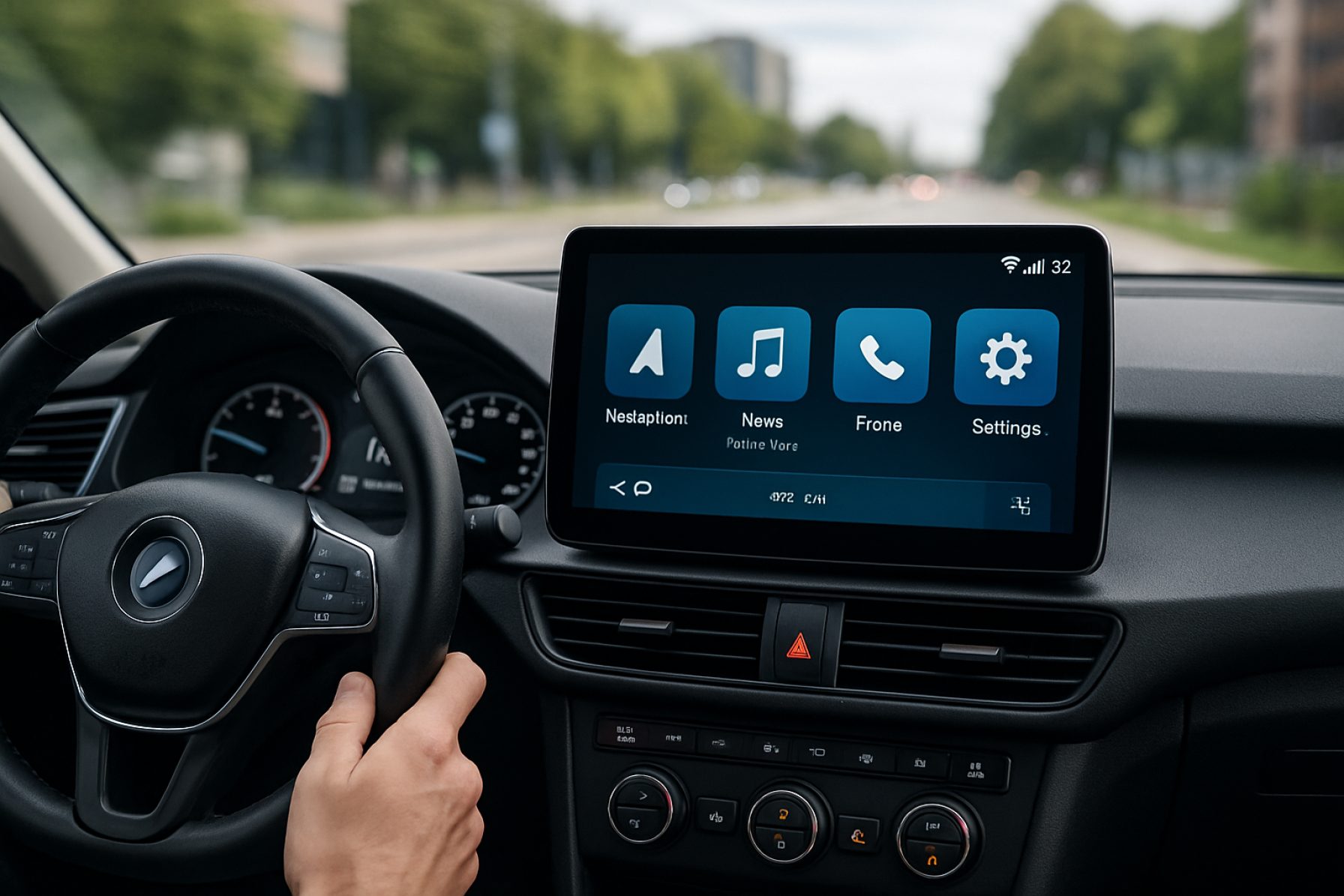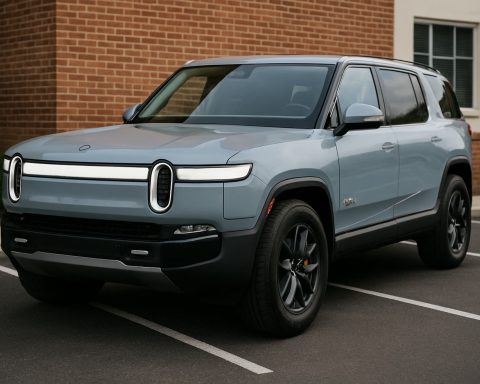Wireless In-Vehicle Infotainment Systems Market Report 2025: Trends, Growth Forecasts, and Strategic Insights for the Next 5 Years
- Executive Summary & Market Overview
- Key Technology Trends Shaping Wireless In-Vehicle Infotainment
- Competitive Landscape and Leading Players
- Market Size, Growth Forecasts & CAGR Analysis (2025–2030)
- Regional Market Analysis: North America, Europe, Asia-Pacific & Rest of World
- Future Outlook: Innovations and Emerging Use Cases
- Challenges, Risks, and Strategic Opportunities
- Sources & References
Executive Summary & Market Overview
Wireless In-Vehicle Infotainment (IVI) Systems represent a transformative segment within the automotive electronics market, integrating wireless connectivity, multimedia, navigation, and telematics to enhance the driving experience. As of 2025, the global market for wireless IVI systems is experiencing robust growth, driven by increasing consumer demand for seamless connectivity, the proliferation of smart devices, and the automotive industry’s shift toward connected and autonomous vehicles.
According to MarketsandMarkets, the global in-vehicle infotainment market is projected to reach USD 30.4 billion by 2025, with wireless solutions accounting for a rapidly growing share. The adoption of wireless technologies such as Bluetooth, Wi-Fi, and cellular connectivity (including 5G) is enabling automakers to offer advanced features like over-the-air (OTA) updates, real-time navigation, streaming services, and smartphone integration without the need for physical connections.
Key industry players—including Bosch Mobility, Panasonic Automotive, and Harman International—are investing heavily in R&D to develop intuitive, customizable, and secure wireless IVI platforms. These systems are increasingly leveraging cloud-based services, voice assistants, and AI-driven personalization to differentiate offerings and meet evolving consumer expectations.
Regionally, North America and Europe remain at the forefront of wireless IVI adoption, supported by high vehicle electrification rates, stringent safety regulations, and a tech-savvy consumer base. However, Asia-Pacific is emerging as the fastest-growing market, fueled by rising automotive production, urbanization, and the rapid rollout of high-speed mobile networks, particularly in China and India (Statista).
Looking ahead to 2025, the wireless IVI market is poised for continued expansion, underpinned by:
- Automakers’ focus on differentiating vehicles through digital experiences
- Growing partnerships between OEMs and technology providers
- Regulatory support for connected vehicle infrastructure
- Consumer demand for safety, convenience, and entertainment features
In summary, wireless in-vehicle infotainment systems are set to play a pivotal role in the evolution of connected mobility, shaping the future of automotive user experience and value creation.
Key Technology Trends Shaping Wireless In-Vehicle Infotainment
Wireless in-vehicle infotainment (IVI) systems are rapidly transforming the automotive experience, offering seamless connectivity, entertainment, and information access without the constraints of physical cables. As the automotive industry moves toward 2025, several key technology trends are shaping the evolution and adoption of wireless IVI systems.
- Integration of 5G Connectivity: The rollout of 5G networks is a pivotal driver for wireless IVI systems, enabling ultra-fast data transfer, low latency, and reliable connections. This allows for real-time streaming, cloud-based services, and enhanced vehicle-to-everything (V2X) communication. Automakers such as BMW Group and General Motors are already integrating 5G modules into their latest models, paving the way for advanced wireless infotainment experiences.
- Wireless Smartphone Integration: Technologies like Apple CarPlay and Android Auto have evolved to support wireless connections, eliminating the need for USB cables. This trend is accelerating, with over 80% of new vehicles in North America expected to offer wireless smartphone mirroring by 2025, according to Strategy Analytics.
- Over-the-Air (OTA) Updates: Wireless IVI systems increasingly rely on OTA updates to deliver new features, security patches, and bug fixes. This reduces the need for dealership visits and ensures that infotainment platforms remain current. Tesla and Ford are industry leaders in leveraging OTA capabilities for both infotainment and vehicle systems.
- Enhanced In-Car Wi-Fi and Hotspot Services: Automakers are partnering with telecom providers to offer robust in-car Wi-Fi, supporting multiple devices and high-bandwidth applications. AT&T and Verizon are expanding their automotive connectivity solutions, making wireless infotainment more accessible and reliable.
- Voice and Gesture Control: Advances in natural language processing and sensor technology are enabling more intuitive, hands-free control of wireless IVI systems. Mercedes-Benz’s MBUX and BMW Group’s iDrive 8 exemplify this trend, offering sophisticated voice assistants and gesture-based interfaces.
These technology trends are collectively driving the wireless IVI market toward greater convenience, personalization, and safety, setting the stage for a new era of connected mobility in 2025 and beyond.
Competitive Landscape and Leading Players
The competitive landscape of the wireless in-vehicle infotainment (IVI) systems market in 2025 is characterized by rapid technological innovation, strategic partnerships, and a strong focus on user experience. The market is dominated by a mix of established automotive suppliers, technology giants, and emerging startups, all vying to capture a share of the growing demand for connected, wireless infotainment solutions.
Key players include Robert Bosch GmbH, Continental AG, Panasonic Automotive Systems, HARMAN International (a subsidiary of Samsung), and Alpine Electronics. These companies leverage their extensive R&D capabilities and established relationships with automakers to deliver advanced wireless IVI platforms that support features such as over-the-air (OTA) updates, wireless smartphone integration (e.g., Apple CarPlay, Android Auto), and cloud-based services.
Tech companies like Qualcomm Technologies, Inc. and NXP Semiconductors play a crucial role by providing the chipsets and connectivity solutions that enable high-speed wireless communication within vehicles. Their platforms support Wi-Fi 6, Bluetooth 5.2, and emerging 5G standards, which are essential for seamless infotainment experiences and real-time data exchange.
Automakers themselves are increasingly developing proprietary infotainment ecosystems or collaborating with technology partners. For example, Tesla, Inc. continues to set benchmarks with its vertically integrated, software-driven infotainment systems, while Volkswagen AG and Toyota Motor Corporation have invested in custom platforms that emphasize wireless connectivity and app integration.
Startups and niche players, such as Aptiv PLC and Visteon Corporation, are also making significant inroads by offering modular, scalable wireless IVI solutions tailored for electric vehicles and next-generation mobility services.
The competitive environment is further shaped by strategic alliances, such as the partnership between HARMAN International and Microsoft to integrate cloud-based services, and the collaboration between Qualcomm and BMW Group for advanced wireless connectivity. As the market matures, differentiation will increasingly hinge on software capabilities, seamless wireless integration, and the ability to deliver personalized, upgradable user experiences.
Market Size, Growth Forecasts & CAGR Analysis (2025–2030)
The global market for wireless in-vehicle infotainment (IVI) systems is poised for robust expansion between 2025 and 2030, driven by increasing consumer demand for seamless connectivity, advancements in wireless communication technologies, and the proliferation of connected vehicles. According to recent projections, the wireless IVI market is expected to reach a valuation of approximately USD 18.7 billion by 2025, with a compound annual growth rate (CAGR) estimated at 10.2% through 2030, ultimately surpassing USD 30.4 billion by the end of the forecast period MarketsandMarkets.
This growth trajectory is underpinned by several key factors. Automakers are increasingly integrating wireless technologies such as Bluetooth, Wi-Fi, and cellular connectivity (including 5G) into infotainment platforms to support features like over-the-air (OTA) updates, real-time navigation, and streaming services. The shift toward electric and autonomous vehicles is further accelerating the adoption of advanced wireless IVI systems, as these vehicles require sophisticated user interfaces and connectivity solutions International Data Corporation (IDC).
Regionally, Asia-Pacific is anticipated to dominate the wireless IVI market, accounting for over 40% of global revenue by 2025, fueled by high vehicle production volumes in China, Japan, and South Korea, as well as rapid urbanization and rising disposable incomes. North America and Europe are also significant contributors, with strong demand for premium vehicles and stringent regulatory requirements for in-car connectivity and safety features Statista.
- Passenger vehicles remain the largest segment, but commercial vehicles are expected to exhibit the fastest growth due to increasing fleet connectivity needs.
- OEM-installed systems will continue to outpace aftermarket solutions, as automakers prioritize factory integration of wireless infotainment platforms.
- 5G-enabled IVI systems are projected to see the highest CAGR, particularly in premium and electric vehicle segments.
In summary, the wireless in-vehicle infotainment systems market is set for significant expansion from 2025 to 2030, with technological innovation, regional automotive trends, and evolving consumer expectations serving as primary growth drivers.
Regional Market Analysis: North America, Europe, Asia-Pacific & Rest of World
The global market for wireless in-vehicle infotainment (IVI) systems is experiencing robust growth, with regional dynamics shaped by technological adoption, automotive production, and consumer preferences. In 2025, North America, Europe, Asia-Pacific, and the Rest of the World (RoW) each present distinct opportunities and challenges for market participants.
- North America: The North American market is characterized by high penetration of connected vehicles and strong consumer demand for advanced infotainment features. Automakers in the United States and Canada are rapidly integrating wireless technologies such as Wi-Fi, Bluetooth, and cellular connectivity to support seamless smartphone integration and over-the-air (OTA) updates. The presence of leading automotive OEMs and technology providers, such as Ford Motor Company and General Motors, accelerates innovation. According to Allied Market Research, North America is expected to maintain a significant share of the global wireless IVI market in 2025, driven by consumer expectations for premium in-car experiences.
- Europe: Europe’s market is propelled by stringent regulatory standards for vehicle safety and connectivity, as well as a strong focus on electric and hybrid vehicles. Automakers such as Volkswagen AG and BMW Group are at the forefront of integrating wireless infotainment systems that support advanced driver assistance and navigation features. The European Union’s push for digitalization and smart mobility further boosts adoption. Statista projects steady growth in wireless IVI adoption across Western Europe, particularly in Germany, France, and the UK.
- Asia-Pacific: Asia-Pacific is the fastest-growing region, fueled by rising vehicle production, urbanization, and increasing disposable incomes. China, Japan, and South Korea are leading markets, with domestic OEMs like Toyota Motor Corporation and Hyundai Motor Company investing heavily in wireless infotainment platforms. The proliferation of 5G networks and government initiatives to promote smart transportation are key growth drivers. Mordor Intelligence highlights Asia-Pacific’s potential to surpass other regions in wireless IVI system adoption by 2025.
- Rest of the World (RoW): In regions such as Latin America, the Middle East, and Africa, adoption is slower but rising, supported by gradual improvements in connectivity infrastructure and growing demand for connected vehicles. Localized solutions and partnerships with global technology providers are helping to bridge the gap. MarketsandMarkets notes that while market share remains modest, RoW regions represent untapped potential for future expansion.
Future Outlook: Innovations and Emerging Use Cases
The future outlook for wireless in-vehicle infotainment (IVI) systems in 2025 is shaped by rapid technological innovation and the emergence of new use cases that extend far beyond traditional audio and navigation functionalities. As automakers and technology providers race to differentiate their offerings, several key trends are expected to define the next generation of wireless IVI systems.
One of the most significant innovations is the integration of 5G connectivity, which will enable ultra-low latency, high-bandwidth data transfer, and seamless cloud-based services. This advancement is expected to support real-time streaming, over-the-air (OTA) software updates, and enhanced vehicle-to-everything (V2X) communication, paving the way for more immersive and interactive infotainment experiences. According to Qualcomm, automotive 5G platforms are already being adopted by leading OEMs, with mass deployment anticipated in 2025.
Artificial intelligence (AI) and machine learning are also set to play a pivotal role in personalizing infotainment content and optimizing user interfaces. AI-driven voice assistants, gesture controls, and predictive recommendations will become standard features, enhancing driver and passenger engagement. Gartner projects that automotive AI revenue will reach $14 billion by 2025, with infotainment systems being a primary driver of this growth.
Emerging use cases are expanding the scope of wireless IVI systems. For instance, in-car gaming, video conferencing, and remote work capabilities are gaining traction, especially as autonomous driving technologies mature and free up occupants’ attention. Partnerships between automakers and content providers, such as Netflix and Spotify, are expected to proliferate, offering seamless access to entertainment and productivity platforms.
Additionally, the rise of electric vehicles (EVs) is influencing IVI innovation. As charging times remain a consideration, automakers are leveraging wireless infotainment to enhance the in-cabin experience during charging sessions, offering tailored content and services. According to IDC, the convergence of EV adoption and advanced infotainment will be a key differentiator in consumer purchasing decisions by 2025.
In summary, the 2025 landscape for wireless in-vehicle infotainment systems will be defined by 5G connectivity, AI-driven personalization, expanded entertainment and productivity use cases, and deeper integration with the evolving EV ecosystem.
Challenges, Risks, and Strategic Opportunities
The wireless in-vehicle infotainment (IVI) systems market in 2025 faces a complex landscape of challenges, risks, and strategic opportunities as automakers and technology providers race to meet evolving consumer expectations and regulatory demands. One of the primary challenges is ensuring robust cybersecurity. As wireless connectivity becomes ubiquitous, vehicles are increasingly vulnerable to cyberattacks targeting infotainment systems, which can serve as entry points to critical vehicle controls. Automakers must invest in advanced encryption, regular software updates, and secure over-the-air (OTA) protocols to mitigate these risks, as highlighted by National Highway Traffic Safety Administration guidelines and recent industry advisories.
Interoperability and standardization also present significant hurdles. The proliferation of wireless protocols—such as Bluetooth, Wi-Fi, 5G, and emerging vehicle-to-everything (V2X) standards—creates integration challenges for OEMs and Tier 1 suppliers. Fragmented standards can lead to inconsistent user experiences and compatibility issues, particularly as consumers expect seamless connectivity with a wide range of personal devices. Industry consortia like the Connectivity Standards Alliance are working to address these gaps, but full harmonization remains a work in progress.
Another risk is the rapid pace of technological obsolescence. Consumer electronics cycles are much shorter than automotive development timelines, making it difficult for automakers to keep IVI systems current. This can result in vehicles shipping with outdated hardware or software, negatively impacting customer satisfaction and brand perception. Strategic partnerships with technology firms and the adoption of modular, upgradable platforms—such as those promoted by Qualcomm and NVIDIA—offer opportunities to future-proof IVI offerings and reduce time-to-market for new features.
On the opportunity side, the shift toward software-defined vehicles and the rise of subscription-based services open new revenue streams. Automakers can leverage wireless IVI platforms to deliver personalized content, real-time navigation, and in-car commerce, as demonstrated by initiatives from BMW Group and Tesla. Additionally, the integration of advanced driver-assistance systems (ADAS) and voice-activated controls enhances safety and user engagement, positioning wireless IVI as a central pillar in the connected car ecosystem.
In summary, while the wireless IVI market in 2025 is fraught with technical and strategic risks, proactive investment in security, interoperability, and flexible architectures will be key to unlocking its full potential and capturing emerging opportunities.
Sources & References
- MarketsandMarkets
- Bosch Mobility
- Harman International
- Statista
- Strategy Analytics
- AT&T
- Verizon
- Qualcomm Technologies, Inc.
- NXP Semiconductors
- Volkswagen AG
- Toyota Motor Corporation
- Aptiv PLC
- Microsoft
- International Data Corporation (IDC)
- Allied Market Research
- Hyundai Motor Company
- Mordor Intelligence
- Spotify
- Connectivity Standards Alliance
- NVIDIA
https://youtube.com/watch?v=g4yUZRtd_7g







